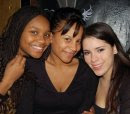I found the trip to be pretty fun and very interesting, I meet up with everyone on the Conner of west 72ND and central park west and was really surprised to see how many people had heard about the tour and more importantly were actually interested enough to spend most of the day with a man who seemed kinda weird. He greeted everyone with a bizarre song (if you can call it that) using his mouth and a clapping motion, in one hand he held on to all the gear he would need for the journey he was about to lead us on and in the other hand he pushed his five year old daughter Violet in a stroller while taking long odd steps through central park.
Wildman Steve Brill definitely knew everything there was to know about what was growing in central park, he knew the good plants from the bad and was able to show us by identifying very small but significant details. One of the first plants we stopped at was about 100 feet away from the busy city streets It was known as the poor mans pepper, it is a member of the mustard family. Not only does its spicy flavor and leafy texture go good in salads and in sandwiches its medicinal purpose is extremely affective preventing peoples chances in being diagnosed with cancer.He brought up a good point he said you would be better off eating the stuff in central park than buying the industrialized food that you find in all of the supermarkets. Who knew you could survive on what is literally in our "version of" a backyard. That made me think, why do we insist on buying produce that is overly produced in chemically and artificially made factories when we could eat food that is grown in small amounts the right way? As Americans we eat the way we are taught and what is put on our plates, for hundreds of years the "normal" way is to eat is the commercial way. If When the population was smaller and families were living off the local farms foods was instilled as technology advanced we may have been less dependent on industrialized foods.
Some of the other plants we stopped to take a closer look at were called the common spice bush; Wildmans advice was that it was best used as tea, taking a handful of leaves of the steams crushing them in your hands and then sticking them in a pit of boiling wait for about 20 minutes, it medicinal purpose is that is can help cure fevers. This plant was ironically 15 feet from a hot got stand. Another plant we saw prevented gas and flatulence and served as helpful aids during pregnancy and child birth. Throughout the tour he dropped useful hints for anyone who loved the outdoors and spends a lot of time exploring "natures possibilities". For example he said the best time for finding mushrooms is after heavy rain, they tend to grow well when surrounded by wood chips, or under trees. While walking along the bike path we came across a plant found on a grassy hill,little did we know it would have to do a lot with out unit on industrialized foods. The plant (although i can not recall the name) was originally discovered by the Johnson brother,after they were bitten by mosquito's. They needed something to relieve the itchiness and irritation. That one small discovery made in the woods by natural resources turned out to become a multi million dollar corporation known as Johnson and Johnson, who know not only have one product but thousands.
I was really surprised to see how much there was to learn about our natural environment and resources. I was only with him for a few hours and learned more in that time than i have in my life anywhere else, i cannot imagine how much more there is to know. If people were to eat from only things that they could find in parks, forests and the woods it would take a lot of time to learn what is okay for your body.I think most Americans see it as a commitment to eat the natural way, people hear the word "vegan"or "vegetarian" and think it will take too much time out of their "busy and hectic" schedules to take the time and shop a little differently to in the end benefit their health. We as Americans are really lazy even when it comes to out health.
Subscribe to:
Post Comments (Atom)

No comments:
Post a Comment